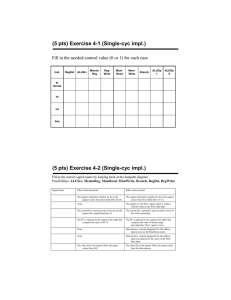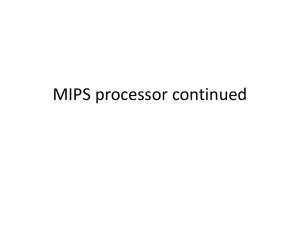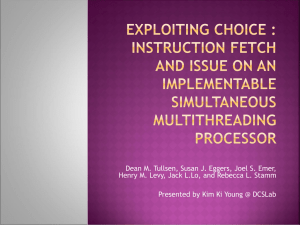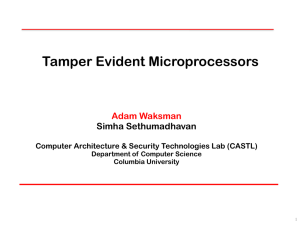Venkataramani
advertisement
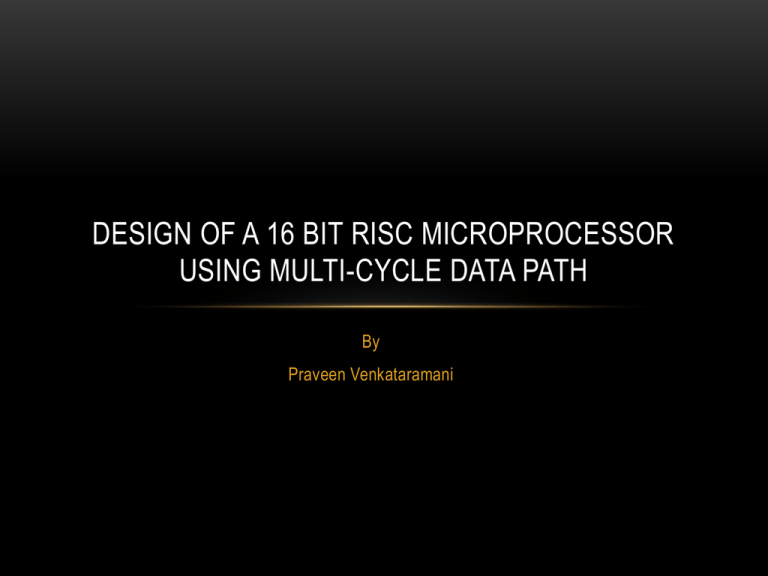
DESIGN OF A 16 BIT RISC MICROPROCESSOR USING MULTI-CYCLE DATA PATH By Praveen Venkataramani INSTRUCTION SET ARCHITECTURE • Maximum allowable instruction N =16 • • Number of op-code bits = log2N = log216 = 4 bits Number of bits in the instruction word = 16 bits • Bits allocated in for R-Type Instruction Format (explained below) = 16/4 = 4 bits each • Total number of registers = 2^No of bits allocated for the operands = 2^4 = 16 registers • Register number goes from 0 -> 15 • Number of permissible instructions per word = 1 • Relative address size = 16 words = log216 = 4 bits long • Absolute address size= 8K words = log 2 (8k) = 13 bits long • Op-code = 3 bits long • Conflict with op-code • Absolute address reduced to 12 bits INSTRUCTIONS • R-Type Instruction • Addition, subtraction, AND, OR, & hold (no-operation) • I- Type Instruction • Load word, Store word • Add immediate • Branch on equal, Branch on not equal • Branch on less than, Branch on less than and equal • Branch on greater than, Branch on greater than and equal • J-Type instruction • Jump and Return, Jump CHOICE OF DATA PATH • Pros: • Shared components • Simple data path Architecture • Easy to debug in code • Availability of materials for design • Cons • Requires intermediate registers to store values between clock cycles • Larger control logic • Requires finite state machine for control logic CHOICE OF SHARED COMPONENTS Component Name Shared/ Dedicated Operation Memory Shared Store both data and instructions Register File Dedicated Store the register data for computation ALU Shared Arithmetic operations Increment PC Computes Branch Address Instruction Register Dedicated Intermediate register to store instruction word from the Memory Memory Data Register Dedicated Intermediate register to store the data to be written into the register during “load” operation A and B Registers Dedicated Intermediate register to store data for computation ALUOUT Dedicated Intermediate register to store output of the ALU PC Dedicated Stores the address of the next instruction MULTI-CYCLE DATA PATH PROGRAM ASSEMBLY LANGUAGE START L1 MACHINE LANGUAGE OPCODE RS RT/RD addi $2,$0,2 1101 0000 0010 RD/ADDRESS/CONST ANT 0010 addi $12,$0,-4 1101 0000 1100 1100 addi $14,$0,-2 1101 0000 1110 1110 add $4,$2,$2 0000 0010 0010 0100 sub $4,$4, $2 0001 0100 0010 0100 sub $10,$12,$2 0001 1100 0010 1010 sub $5,$2,$4 0001 0010 0100 0101 sub $7,$14,$4 0001 1110 0100 0111 beq $4,$2,L1 0111 0010 0100 1011 jmp START 1111 000000000001 DATA PATH WITH FORCED CONTROL LOGIC DATA PATH WITH FORCED CONTROL LOGIC CONTROL STATES Instruction Fetch Instruction Decode LW/SW R- Type Address Computation Write Memory Execution Read Memory Write Register Write Register Branch Type Jump Type BRANCH CONTROL SIGNAL • Instruction fetch – • PC Write =1 • ALUSRC B= 01 Instruction Fetch • ALUSRC A = 0 • PC Source =00 • Instruction Decode• PC Write = 0 Branch Decision Instruction Decode • ALUSRC B = 10 • Branch Decision • ALUSRC A = 1 • ALUSRC B = 00 BRANCH INSTRUCTION JUMP CONTROL SIGNALS • Instruction fetch – • PC Write -1 • ALUSRC B – 01 Instruction Fetch • ALUSRC A – 0 • PC Source =00 • Instruction Decode• PC Write – 0 Unconditional Jump Instruction Decode • ALUSRC B – 10 • Jump Execution • PC Source =10 JUMP TYPE INSTRUCTION R –TYPE INSTRUCTION • Instruction Fetch • Write Register Instruction Decode • • Execution Instruction fetch – • PC Write -1 • ALUSRC B – 01 • ALUSRC A – 0 Instruction Decode• PC Write – 0 • ALUSRC B – 10 Execution • ALUSRC A = 1 • ALUSRC B = 0 Write Register – • Read Write – 1 • Register Destination – 1 • Memory to Register - 0 R-TYPE INSTRUCTION STORE WORD CONTROL SIGNALS • Instruction Fetch • Write into memory Instruction Decode Address calculation • • Instruction fetch – • PC Write =1 • ALUSRC B= 01 • ALUSRC A = 0 Instruction Decode• PC Write = 0 • ALUSRC B = 10 Address calculation • ALUSRC A = 1 • ALUSRC B = 10 Write Memory – • I or D = 1 • Memory write = 1 STORE WORD INSTRUCTION LOAD WORD CONTROL SIGNALS • Instruction Fetch • Write register Instruction Decode • • Read Memory Address Calculation • Instruction fetch – • PC Write =1 • ALUSRC B= 01 • ALUSRC A = 0 PC Source =00 Instruction Decode• PC Write = 0 • ALUSRC B = 10 Address calculation • ALUSRC A = 1 • ALUSRC B = 10 Read Memory – • I or D = 1 • Memory write = 0 Write Register • RW =1 • Register destination = 0 • Memory to Register = 1 LOAD WORD INSTRUCTION CPU SIMULATION CONCLUSION • The project provided an hands experience in actual design of a CPU • What we learnt • • RTL Programming in VHDL • Use of FPGA boards • Trouble shooting and testing • Different types of data paths Advice to people • Check each component in the data path with and without control unit while simulating • Do the same on the board • Do not be stingy in using the pins or switches use as many to test each component • Note you can save the pin configuration for future use by exporting it • Simplicity in code • Sometimes laziness helps – so save your simulation commands in a .do file / text file • Isolate and test • Only write enable in the memory- writes when asserted; reads always. • While using pulse switch for clock, keep in mind that after some time the keys might get sloppy and may double clock the circ uit
